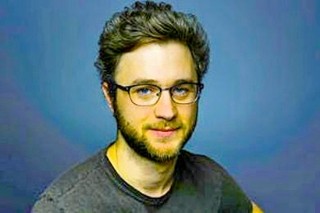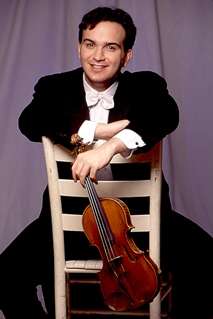|
Back
Fit To Te Tide New York
Isaac Stern Auditorium, Carnegie Hall
11/20/2014 -
Samuel Adams: Drift and Providence (New York Premiere)
Sergei Prokofiev: Violin Concerto No. 2 in G Minor, Opus 63
Maurice Ravel: Daphnis et Chloé (complete)
Gil Shaham (Violin)
New York Choral Artists, Joseph Flummerfelt (Chorus Director), San Francisco Orchestra, Michael Tilson Thomas (Music Director/Conductor)

S. Adams (© Wikipedia Commons)
First Man (standing on the shore of the Pacific Ocean): “That’s the most immense amount of water I’ve ever seen in my life.”
Second Man: “Don’t forget, you’re only looking at the top! There’s a lot more water underneath.”
Samuel Adams packed a whole lot of water atop and (and probably underneath) his Drift and Providence last night, the first work played by the San Francisco Orchestra. For nineteen minutes, the orchestra and Mr. Adams’ “sound design” played a mass of sounds, some with undertows, some simply massive blocks of sound.
It wasn’t actually supposed to be water. In Mr. Adams’ words, “This piece aims to develop a reactive sonic environment suggestive of a more contemporary disposition–that the water from whence we came is an object of psychological remove in a highly digitized and distracted life.”
I have no reason not to believe him. Samuel Adams has shown before a uniquely eclectic talent embracing even more genres than his father. Growing up in California, nothing was outside of his ken, whether jazz, electronic, aleatory, symphonic, hip-hop or music of the streets and mountains.
And in last night’s performance, he used not only a huge orchestra but a laptop computer and mixer board operated by the composer at the back of Carnegie Hall, echoing and reverbing in real time the sounds of the percussion ensemble.
If you listened carefully, the five movements used these electronic sounds, as well as blues notes, outbursts of jazz, more outbursts emanating through the orchestra, hints of Debussy’s La Mer, subtle changes of rhythm.
It is a highly estimable work, but I kept thinking that all the massive energy which went into not only the music but the conception of the music was sometimes wasted. For, outside of those quark-ish sounds and changes of rhythm under the mass, we heard a classic quantum experiment with waves and particles, all moving within a static universe of its own.
Against my will, I kept thinking of another “water” piece by another Adams, John Luther Adams. His Pulitzer Prize-winning Become Ocean was both mystic and ocean and powerful and moving. Without any program notes, he had created a musical universe. Samuel Adams merged a conglomeration of materials and carved out a brainy sculpture.
Michael Tilson Thomas has never lost that inventive sense, and he must be honored for bringing us Samuel Adams’ music, conducted with that animated precise feeling which he has for all his works. In fact, I wanted so much to use an adjective for his conducting which would have sounded out of place in the Mahler played two nights ago. Mr. Tilson Thomas is one of the most nimble conductors working today. Always atop his music, conserving strength when his great orchestra is on its own, but always ready to lend a hand, as he did in the two other works.

G. Shaham (© Boyd Hagen)
One had no doubt that Gil Shaham could have sailed through the Prokofiev Second Violin Concerto the way Joshua Bell cruised through the Glazunov Concerto last week. But I have never yet heard Mr. Shaham sail easily through anything.
His Strad has a glorious sweet tone, his own technique and artistry are beyond criticism. But Mr. Shaham puts every bit of energy and concern into each note he plays. Although he has worked with Mr. Tilson Thomas on innumerable occasions, one is under the illusion that both of them were playing the Prokofiev as if they’d never played it before: experimenting, going forward, like a virgin, fiddled for the very first time.
Compared to the massive orchestration of the Adams and Ravel works, this Concerto had a lean and hungry sound. Both Shaham and Tilson Thomas have Russian ancestry, and they were able to pull from the Prokofiev melodies some arcane Russian messages. Mr. Shaham eschewed even a hint that this was a bravura concerto (though it decidedly was). Instead, he kept his emotionality in check, he surveyed those lines with warmth that was never heated, with the mystery of gorgeous inspiration.
The last half of the concert was devoted to the complete Ravel Daphnis et Chloé, including the wordless highly dramatic New York Choral Artists, and with the largest orchestra Ravel had ever assembled. And for those who consider Ravel to be amongst the most fastidious, classical, and controlled composers, Mr. Tilson Thomas’s Ravel was a libidinous wonderland.
Yes, the original ballet ended with an old-fashioned orgy, but the San Francisco Orchestra gave a ferociously carnal touch to every moment of the “choreographic symphony in three parts”.
An hour of orgasms might be a bit too much for even the most prurient listener, but Mr. Tilson Thomas and the San Francisco Orchestra and the New York Choral Artists offered not only Ancient Attic enchantment, but they rose and fell from foreplays to consummations with unholy ecstasy.
Harry Rolnick
|